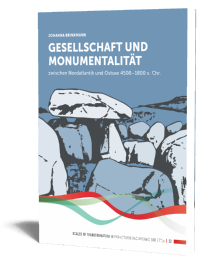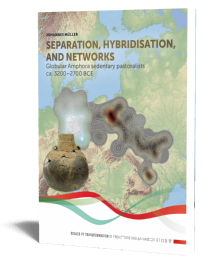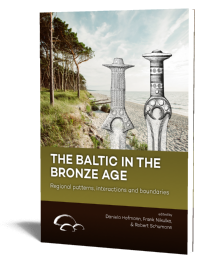Population dynamics and land-use patterns in the southwestern Baltic region during the Neolithic and the Bronze Age
Giacomo Bilotti | Forthcoming
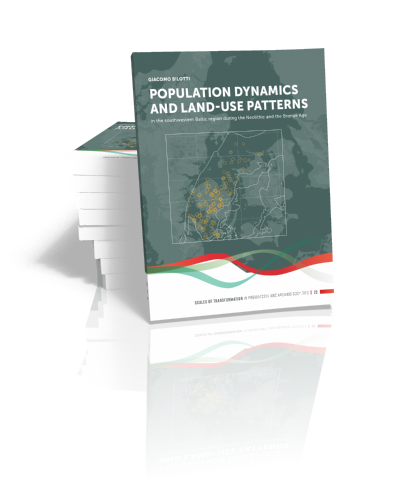
Population dynamics and land-use patterns in the southwestern Baltic region during the Neolithic and the Bronze Age
Giacomo Bilotti | Forthcoming
Paperback ISBN: 9789464281149 | Hardback ISBN: 9789464281156 | Imprint: Sidestone Press Dissertations | Format: 210x280mm | ca. 200 pp. | Scales of Transformation 23 | Series: Scales of Transformation | Language: English | 7 illus. (bw) | 55 illus. (fc) | Keywords: archaeology; prehistory; demography; Bronze Age; Neolithic; spatial statistics; population dynamics; northern Europe; Baltic | download cover | DOI: 10.59641/3t0242wf | CC-license: CC BY 4.0
Publication date: 26-03-2026
-
Digital & Online access
Digital/Online version not (yet) available
-
Buy via Sidestone (EU & UK)
Get €5.00 discount on forthcoming books by using coupon code "PRE-ORDER" in your shopping cart!
-
Buy via our Distributors (WORLD)
For non-EU or UK destinations you can buy our books via our international distributors. Although prices may vary this will ensure speedy delivery and reduction in shipping costs or import tax. But you can also order with us directly via the module above.
For UK & other International destinations
For USA/Canada & other International destinations
-
Bookinfo
Paperback ISBN: 9789464281149 | Hardback ISBN: 9789464281156 | Imprint: Sidestone Press Dissertations | Format: 210x280mm | ca. 200 pp. | Scales of Transformation 23 | Series: Scales of Transformation | Language: English | 7 illus. (bw) | 55 illus. (fc) | Keywords: archaeology; prehistory; demography; Bronze Age; Neolithic; spatial statistics; population dynamics; northern Europe; Baltic | download cover | DOI: 10.59641/3t0242wf | CC-license: CC BY 4.0
Publication date: 26-03-2026

We will plant a tree for each order containing a paperback or hardback book via OneTreePlanted.org.
This work aims to study population dynamics and land-use patterns in the South-Western Baltic region during the Neolithic and Bronze Age (4100 to 500 BCE). Understanding demography is essential for comprehending socio-cultural transformations, as demographic patterns have long been recognised as major drivers of social change and complex dynamics. Palaeodemography has gained momentum in archaeology and become a central aspect of the discipline thanks to recent methodological and computational advances. Despite that, the discipline faces several challenges due to the patchiness of archaeological data.
In order to overcome this issue, this study uses a multi-proxy and formal approach aiming to reduce chronological uncertainty and improve spatial resolution, thereby enhancing understanding of regional variations. This study produced two different estimates: labour-based carrying capacity and absolute demographic reconstructions. In none of the study regions the carrying capacity was reached, challenging the hypothesis of a correlation between population dynamics and reaching the full capacity of a region. The study also identified patterns of growth and decline in absolute demographic estimates. These patterns align with the boom and bust phases identified in the literature for many European regions.
However, each sub-area exhibited distinct patterns in terms of absolute change and the timing of peaks, which cannot be observed at regional or supra-regional scales. Despite these differences, global population trends across sub-regions were identifiable, with a general demographic increase during the Early Neolithic, peaking in the Middle Neolithic, followed by a period of lower population densities during the Younger Neolithic. The patterns for the Late Neolithic and Bronze Age varied depending on the region. Comparisons with other studies show that while global trends were identified, some are either smoothed out in large-scale studies or incorrectly identified and points towards the necessity of a more localised, yet formal and fully reproducible, approach to palaeodemography.
1 Introduction
1.1 Study region
1.1.1 Coordinates and reference systems
1.1.2 Landscape and geomorphology
1.2 Technical requirements
2 State of the archaeological research in the region
2.1 Chronology
2.1.1 The Funnel Beaker Group: Early and Middle Neolithic
2.1.1.1 The Early and Middle Neolithic landscape
2.1.1.2 Settlements and houses during the TRB
2.1.1.3 Burial practices during the TRB
2.1.2 Young Neolithic
2.1.3 Late Neolithic
2.1.3.1 Late Neolithic settlement structure
2.1.3.2 Late Neolithic funerary practice
2.1.4 Bronze Age
2.1.4.1 Metal economy and social organisation
2.1.4.2 Barrow construction and demographic estimates
3 Data
3.1 Archaeological data
3.1.1 Germany
3.1.1.1 Mecklenburg-Western Pomerania
3.1.1.2 Schleswig-Holstein
3.1.2 Sweden
3.1.2.1 Site typologies
3.1.3 Denmark
3.1.4 Case study selection
3.2 Radiocarbon data
3.3 Environmental data
3.3.1 Elevation and distance-based variables
3.3.2 Soil and geological data
4 Demography
4.1 State of the art in palaeodemography
4.1.1 Radiocarbon dating
4.1.2 Demographic fluctuations in northern Germany and southern Scandinavia
4.2 Household size
4.2.1 House size variation in the study area
4.2.2 House duration
4.3 Case studies
4.3.1 Saxån-Ålabäcken valley, western Scania
4.3.1.1 The Early Neolithic
4.3.1.2 Early Neolithic II–Middle Neolithic II
4.3.1.3 Middle Neolithic III–V
4.3.1.4 Demographic estimates
4.3.2 Hyllie area
4.3.2.1 Almhov
4.3.2.2 The other settlements
4.3.3 Thy
4.3.3.1 Bjerre Enge
4.3.3.2 Aas
4.3.4 Cumulative results
5 Methods
5.1 Chronological modelling
5.1.1 Radiocarbon calibration
5.1.2 Summed probability distribution
5.1.3 Kernel density estimation
5.2 Point pattern analysis
5.2.1 Spatial intensity and kernel density estimation
5.2.2 First-order properties
5.2.2.1 Rhohat
5.2.2.2 Point process models
5.2.3 Second-order properties
5.3 Cluster analysis
5.3.1 Cluster analysis in archaeology
5.3.2 Clustering algorithms
5.3.2.1 Square error clustering
5.3.2.2 Density-based clustering
5.3.2.3 Model-based clustering
6 Results
6.1 Chronological modelling
6.2 Point pattern analysis
6.2.1 Point process models
6.2.1.1 Bornholm
6.2.1.2 North-western Zealand
6.2.1.3 Thy
6.2.1.4 Central Jutland
6.2.1.5 East Holstein
6.3 Cluster analysis
6.3.1 Bornholm
6.3.2 North-western Zealand
6.3.3 Thy
6.3.4 Central Jutland
6.3.5 East Holstein
6.3.6 Rügen
6.3.7 South-eastern Schleswig (Dänischer Wohld)
6.3.8 South-western Scania
6.3.9 Western Scania
6.3.10 Bjäre peninsula and North-eastern Scania
6.4 Demographic model
6.4.1 Carrying capacity estimation
6.4.2 Absolute estimates
7 Discussion
7.1 How many?
7.2 Comparison
7.2.1 Relative demographic reconstructions
7.2.2 Absolute demographic reconstructions
7.3 Modelling considerations
8 Conclusions
References
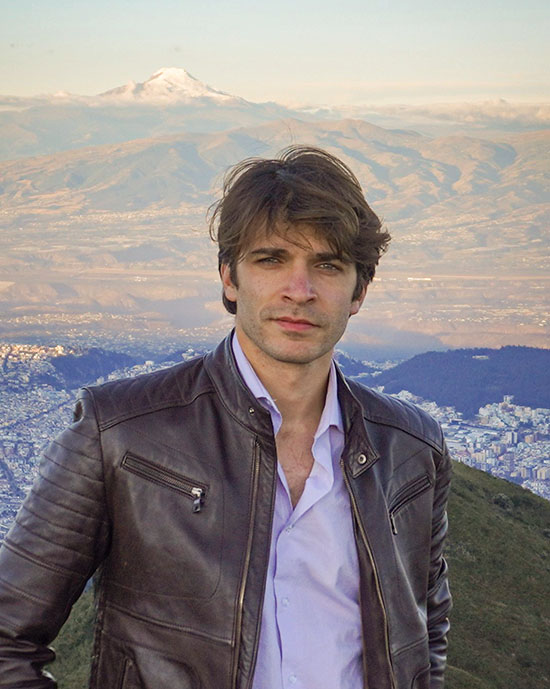
Dr. Giacomo Bilotti
Giacomo Bilotti’s research interests lie in computational archaeology, with a particular focus on the application of statistical methods, including spatial statistics. He obtained his PhD from Kiel University (Germany) in 2024, with a thesis on demographic patterns in prehistoric northern Europe. Prior to his PhD, he studied archaeology at the University of Padova (Italy), where he earned his Master’s degree in 2019 and his Bachelor’s degree in 2017.
Abstract:
This work aims to study population dynamics and land-use patterns in the South-Western Baltic region during the Neolithic and Bronze Age (4100 to 500 BCE). Understanding demography is essential for comprehending socio-cultural transformations, as demographic patterns have long been recognised as major drivers of social change and complex dynamics. Palaeodemography has gained momentum in archaeology and become a central aspect of the discipline thanks to recent methodological and computational advances. Despite that, the discipline faces several challenges due to the patchiness of archaeological data.
In order to overcome this issue, this study uses a multi-proxy and formal approach aiming to reduce chronological uncertainty and improve spatial resolution, thereby enhancing understanding of regional variations. This study produced two different estimates: labour-based carrying capacity and absolute demographic reconstructions. In none of the study regions the carrying capacity was reached, challenging the hypothesis of a correlation between population dynamics and reaching the full capacity of a region. The study also identified patterns of growth and decline in absolute demographic estimates. These patterns align with the boom and bust phases identified in the literature for many European regions.
However, each sub-area exhibited distinct patterns in terms of absolute change and the timing of peaks, which cannot be observed at regional or supra-regional scales. Despite these differences, global population trends across sub-regions were identifiable, with a general demographic increase during the Early Neolithic, peaking in the Middle Neolithic, followed by a period of lower population densities during the Younger Neolithic. The patterns for the Late Neolithic and Bronze Age varied depending on the region. Comparisons with other studies show that while global trends were identified, some are either smoothed out in large-scale studies or incorrectly identified and points towards the necessity of a more localised, yet formal and fully reproducible, approach to palaeodemography.
Contents
1 Introduction
1.1 Study region
1.1.1 Coordinates and reference systems
1.1.2 Landscape and geomorphology
1.2 Technical requirements
2 State of the archaeological research in the region
2.1 Chronology
2.1.1 The Funnel Beaker Group: Early and Middle Neolithic
2.1.1.1 The Early and Middle Neolithic landscape
2.1.1.2 Settlements and houses during the TRB
2.1.1.3 Burial practices during the TRB
2.1.2 Young Neolithic
2.1.3 Late Neolithic
2.1.3.1 Late Neolithic settlement structure
2.1.3.2 Late Neolithic funerary practice
2.1.4 Bronze Age
2.1.4.1 Metal economy and social organisation
2.1.4.2 Barrow construction and demographic estimates
3 Data
3.1 Archaeological data
3.1.1 Germany
3.1.1.1 Mecklenburg-Western Pomerania
3.1.1.2 Schleswig-Holstein
3.1.2 Sweden
3.1.2.1 Site typologies
3.1.3 Denmark
3.1.4 Case study selection
3.2 Radiocarbon data
3.3 Environmental data
3.3.1 Elevation and distance-based variables
3.3.2 Soil and geological data
4 Demography
4.1 State of the art in palaeodemography
4.1.1 Radiocarbon dating
4.1.2 Demographic fluctuations in northern Germany and southern Scandinavia
4.2 Household size
4.2.1 House size variation in the study area
4.2.2 House duration
4.3 Case studies
4.3.1 Saxån-Ålabäcken valley, western Scania
4.3.1.1 The Early Neolithic
4.3.1.2 Early Neolithic II–Middle Neolithic II
4.3.1.3 Middle Neolithic III–V
4.3.1.4 Demographic estimates
4.3.2 Hyllie area
4.3.2.1 Almhov
4.3.2.2 The other settlements
4.3.3 Thy
4.3.3.1 Bjerre Enge
4.3.3.2 Aas
4.3.4 Cumulative results
5 Methods
5.1 Chronological modelling
5.1.1 Radiocarbon calibration
5.1.2 Summed probability distribution
5.1.3 Kernel density estimation
5.2 Point pattern analysis
5.2.1 Spatial intensity and kernel density estimation
5.2.2 First-order properties
5.2.2.1 Rhohat
5.2.2.2 Point process models
5.2.3 Second-order properties
5.3 Cluster analysis
5.3.1 Cluster analysis in archaeology
5.3.2 Clustering algorithms
5.3.2.1 Square error clustering
5.3.2.2 Density-based clustering
5.3.2.3 Model-based clustering
6 Results
6.1 Chronological modelling
6.2 Point pattern analysis
6.2.1 Point process models
6.2.1.1 Bornholm
6.2.1.2 North-western Zealand
6.2.1.3 Thy
6.2.1.4 Central Jutland
6.2.1.5 East Holstein
6.3 Cluster analysis
6.3.1 Bornholm
6.3.2 North-western Zealand
6.3.3 Thy
6.3.4 Central Jutland
6.3.5 East Holstein
6.3.6 Rügen
6.3.7 South-eastern Schleswig (Dänischer Wohld)
6.3.8 South-western Scania
6.3.9 Western Scania
6.3.10 Bjäre peninsula and North-eastern Scania
6.4 Demographic model
6.4.1 Carrying capacity estimation
6.4.2 Absolute estimates
7 Discussion
7.1 How many?
7.2 Comparison
7.2.1 Relative demographic reconstructions
7.2.2 Absolute demographic reconstructions
7.3 Modelling considerations
8 Conclusions
References

Dr. Giacomo Bilotti
Giacomo Bilotti’s research interests lie in computational archaeology, with a particular focus on the application of statistical methods, including spatial statistics. He obtained his PhD from Kiel University (Germany) in 2024, with a thesis on demographic patterns in prehistoric northern Europe. Prior to his PhD, he studied archaeology at the University of Padova (Italy), where he earned his Master’s degree in 2019 and his Bachelor’s degree in 2017.
-
Digital & Online access
Digital/Online version not (yet) available
-
Buy via Sidestone (EU & UK)
Get €5.00 discount on forthcoming books by using coupon code "PRE-ORDER" in your shopping cart!
-
Buy via our Distributors (WORLD)
For non-EU or UK destinations you can buy our books via our international distributors. Although prices may vary this will ensure speedy delivery and reduction in shipping costs or import tax. But you can also order with us directly via the module above.
For UK & other International destinations
For USA/Canada & other International destinations
- Browse all books by subject
-
Search all books

We will plant a tree for each order containing a paperback or hardback book via OneTreePlanted.org.
You might also like:
© 2025 Sidestone Press KvK nr. 28114891 Privacy policy Sidestone Newsletter Terms and Conditions (Dutch)
